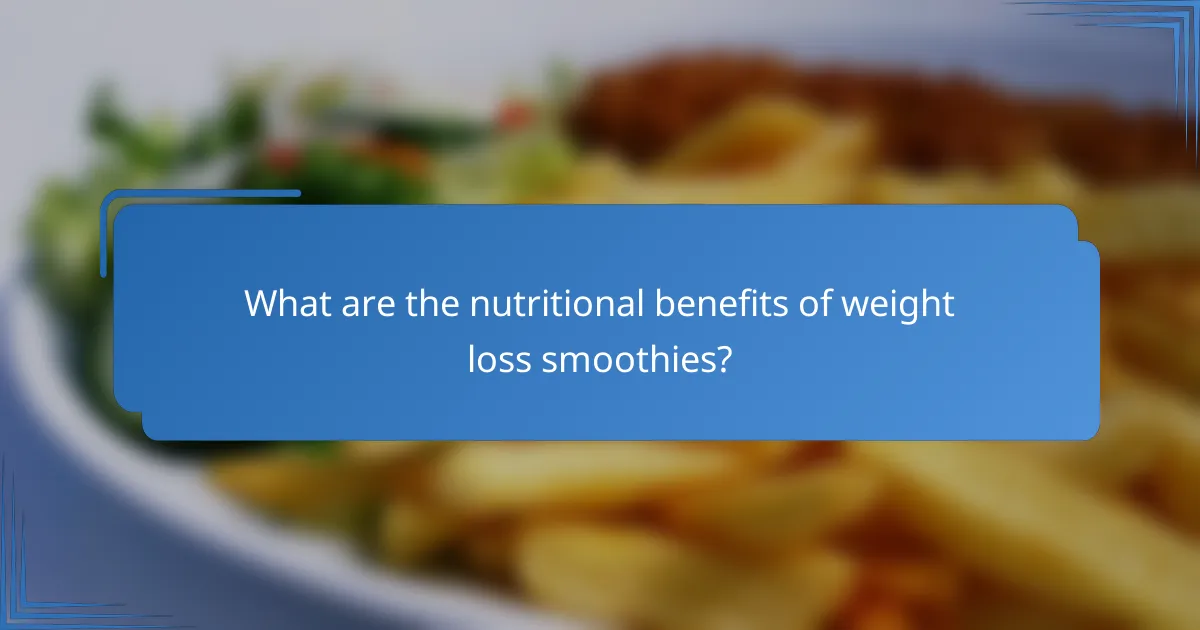Weight loss smoothies can be a delicious and effective way to manage your appetite while keeping calories in check. By incorporating nutrient-dense, high-fiber ingredients like leafy greens and fruits, these smoothies not only provide essential nutrients but also promote feelings of fullness. With the right combination of fiber, protein, and healthy fats, you can create satisfying blends that support your weight loss goals.

What are the best low-calorie smoothies for weight loss?
The best low-calorie smoothies for weight loss are nutrient-dense, high in fiber, and designed to control appetite. These smoothies typically incorporate ingredients like leafy greens, fruits, and low-calorie liquids to keep calories low while providing essential nutrients.
Green smoothie with spinach and cucumber
A green smoothie featuring spinach and cucumber is an excellent choice for weight loss. Spinach is low in calories but high in fiber, which helps you feel full longer. Cucumber adds hydration and a refreshing taste without adding significant calories.
To prepare, blend a handful of spinach with half a cucumber, a small apple for sweetness, and water or unsweetened almond milk. This combination keeps the calorie count low while delivering vitamins and minerals.
Berry smoothie with mixed berries and almond milk
A berry smoothie made with mixed berries and almond milk is both delicious and effective for weight loss. Berries are rich in antioxidants and fiber, which can help control appetite and support metabolic health.
Combine a cup of mixed berries—such as strawberries, blueberries, and raspberries—with a cup of unsweetened almond milk. This smoothie is typically low in calories and can be enjoyed any time of day.
Tropical smoothie with pineapple and coconut water
A tropical smoothie featuring pineapple and coconut water offers a refreshing option for weight loss. Pineapple is low in calories and contains bromelain, which may aid digestion and reduce bloating.
Blend one cup of fresh pineapple chunks with a cup of coconut water for hydration and flavor. This smoothie is naturally sweet and can satisfy cravings without excessive calories.
Chocolate banana smoothie with unsweetened cocoa
A chocolate banana smoothie made with unsweetened cocoa is a satisfying treat that can help curb sweet cravings while remaining low in calories. Bananas provide natural sweetness and fiber, while cocoa adds a rich flavor without added sugars.
To make this smoothie, blend one banana with a tablespoon of unsweetened cocoa powder and a cup of unsweetened almond milk. This combination keeps the calorie count reasonable while delivering a chocolatey taste.

How do high-fiber smoothies aid weight loss?
High-fiber smoothies support weight loss by promoting feelings of fullness and enhancing digestive health. The fiber content helps control appetite, making it easier to reduce overall calorie intake while providing essential nutrients.
Increased satiety from fiber
Fiber-rich smoothies can significantly increase satiety, which helps curb hunger and reduce snacking. Ingredients like oats, chia seeds, and leafy greens are excellent sources of fiber that can keep you feeling full for longer periods.
To maximize satiety, aim for smoothies that contain at least 5 grams of fiber per serving. This can be achieved by incorporating a variety of high-fiber fruits and vegetables, such as berries, bananas, and spinach.
Improved digestion and gut health
High-fiber smoothies contribute to better digestion and gut health by promoting regular bowel movements and supporting beneficial gut bacteria. Soluble fiber, found in ingredients like apples and flaxseeds, can help regulate digestion and prevent constipation.
For optimal gut health, consider adding probiotics through yogurt or kefir to your smoothies. This combination of fiber and probiotics can enhance nutrient absorption and overall digestive function.

What ingredients enhance appetite control in smoothies?
Ingredients that enhance appetite control in smoothies typically include high-fiber components, protein sources, and healthy fats. These elements work together to promote satiety, helping to reduce overall calorie intake.
Chia seeds for added fiber
Chia seeds are an excellent source of dietary fiber, which can help you feel full longer. Just two tablespoons of chia seeds can provide around 10 grams of fiber, contributing to a smoother digestive process and increased feelings of fullness.
When added to smoothies, chia seeds absorb liquid and expand, creating a gel-like texture that can further enhance satiety. Consider blending them into your smoothie or letting them soak in liquid for a few minutes before mixing.
Protein powder for sustained energy
Incorporating protein powder into your smoothies can help maintain energy levels and curb hunger. Protein is known for its satiating properties, making it a valuable addition for those looking to manage their appetite.
Choose a protein powder that suits your dietary preferences, such as whey, pea, or hemp protein. Aim for about 20-30 grams of protein per serving to effectively support appetite control and promote muscle maintenance.
Avocado for healthy fats
Avocado adds healthy fats to smoothies, which can help you feel satisfied and reduce cravings. The monounsaturated fats found in avocados are beneficial for heart health and can contribute to a balanced diet.
Including half an avocado in your smoothie can provide around 15 grams of fat and a creamy texture that enhances flavor. This addition not only aids in appetite control but also makes your smoothie more nutrient-dense.

What are the nutritional benefits of weight loss smoothies?
Weight loss smoothies offer a range of nutritional benefits, primarily by being low in calories while high in fiber. These characteristics help control appetite and promote a feeling of fullness, making them effective for weight management.
Low-calorie options for calorie deficit
To create a calorie deficit, focus on low-calorie ingredients like leafy greens, cucumbers, and berries. These components provide volume without adding significant calories, allowing you to enjoy larger portions while still reducing overall intake.
For example, a smoothie made with spinach, half a banana, and unsweetened almond milk can contain around 100-150 calories. This makes it a smart choice for those looking to lose weight without feeling deprived.
Rich in vitamins and minerals
Weight loss smoothies can be packed with essential vitamins and minerals, especially when incorporating fruits and vegetables. Ingredients like kale, berries, and citrus fruits are not only low in calories but also rich in nutrients like vitamin C, potassium, and antioxidants.
Including a variety of colorful produce in your smoothies ensures a broad spectrum of nutrients, which supports overall health. Aim for at least two different fruits or vegetables in each smoothie to maximize nutritional benefits.

How to choose the right smoothie for weight loss?
Choosing the right smoothie for weight loss involves focusing on low-calorie options that are rich in fiber and protein. This combination helps control appetite and supports a balanced diet.
Consider calorie count and ingredients
When selecting a smoothie, pay close attention to its calorie count and the ingredients used. Aim for smoothies that contain around 150 to 300 calories per serving, which can help you stay within your daily caloric goals.
Look for whole food ingredients such as fruits, vegetables, and unsweetened nut milks. Avoid added sugars and high-calorie additives like syrups or whipped cream, which can significantly increase the calorie content.
Evaluate fiber and protein content
Fiber and protein are crucial for making smoothies satisfying and beneficial for weight loss. A good smoothie should contain at least 5 grams of fiber and 10 grams of protein to help keep you full longer.
Incorporate ingredients like spinach, chia seeds, or oats for fiber, and consider adding Greek yogurt or protein powder for an extra protein boost. This combination not only aids in appetite control but also supports overall health.

What are the best practices for making weight loss smoothies?
To create effective weight loss smoothies, focus on incorporating low-calorie, high-fiber ingredients that promote appetite control. Prioritize whole foods and avoid added sugars to maximize nutritional benefits while keeping calories in check.
Choose the right base
Selecting the right base for your smoothie is crucial. Low-calorie options like unsweetened almond milk, coconut water, or plain yogurt can provide a creamy texture without adding excessive calories. Aim for a serving size of around 1 cup to keep it light.
Incorporate high-fiber ingredients
High-fiber ingredients help keep you feeling full longer, which is essential for weight loss. Consider adding leafy greens like spinach or kale, fruits such as berries or apples, and seeds like chia or flaxseed. Aiming for at least one serving of fiber-rich ingredients can enhance satiety.
Limit added sugars
Minimizing added sugars is vital for maintaining low calorie counts in your smoothies. Instead of sweeteners, rely on the natural sweetness of fruits. If needed, a small amount of honey or maple syrup can be used, but keep it to a teaspoon or less to avoid excess calories.
Balance your ingredients
Striking a balance between carbohydrates, proteins, and fats in your smoothie can optimize its effectiveness for weight loss. Include a source of protein, such as protein powder or Greek yogurt, and healthy fats like avocado or nut butter, while keeping the total calorie count under 300 calories for a meal replacement.
Watch portion sizes
Portion sizes can significantly impact calorie intake. A typical smoothie should be around 12 to 16 ounces. Using a measuring cup can help ensure you don’t exceed recommended serving sizes, which can lead to unintended calorie overload.
